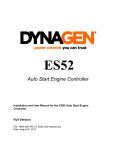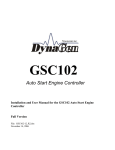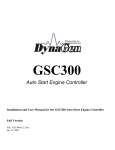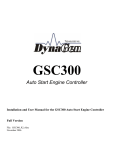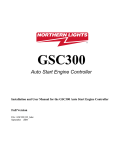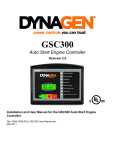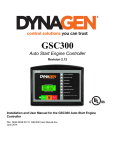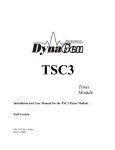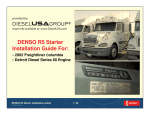Download Dynagen ES52 Manual
Transcript
om m .c al ar ES52 ea m Auto Start Engine Controller ww w. B Installation and User Manual for the ES52 Auto Start Engine Controller. Full Version File: ES52rev2.63.doc October 24, 2006 2 m .c Please Read Manual Before Installing Unit om Thank You For Purchasing This DynaGen Product Receipt of Shipment and Warranty Return Information ar Upon receipt of shipment, carefully remove the unit from the shipping container and thoroughly examine the unit for shipping damage. In case of damage, immediately contact the carrier and request that an inspection report be filed prior to contacting DynaGen. ea m Limited Warranty al All returned items are to be shipped prepaid and include a Return Material Authorization (RMA) number issued by DynaGen. RMA forms are available by contacting DynaGen Technical Support through the contact methods listed below. ww w. B DynaGen will repair or replace any ES52 controller which proves to be defective under normal and proper use within Three Years from the date of shipment. This constitutes the only warranty and no other warranty shall be implied. We welcome your comments and suggestions. Please contact us at: DynaGen Technologies Inc. Phone: 1-888-396-2436 (902) 562 0133 Fax: (902) 567 0633 Email: [email protected] WEB SITE: www.dynagen.ca Operating & Installation Manual for the ES52 Engine Controller Table of Contents INTRODUCTION om 3 4 5 ar WIRING INSTALLATION GUIDELINES Wiring instructions, types and sizes Wiring guidelines Terminal description General Wiring Diagram Outline Dimension Drawing m .c SPECIFICATIONS 6 6 7 8 10 11 12 13 13 14 15 15 16 16 17 17 17 LED INDICATIONS 18 TROUBLESHOOTING GUIDELINES 19 ww w. B ea m al ADJUSTMENTS AND SETUP PROCEDURES Select the engine speed range Oil switch verification - oil switch enabled or disabled Select a timer function Adjusting Timer setting Setup Mode Calibration Crank/Rest time calibration Crank Disconnect calibration Over-speed calibration Select the maximum number of Crank Tries Warmup Operating & Installation Manual for the ES52 Engine Controller 4 om INTRODUCTION The ES52 provides automatic start/stop and protection control for all types of engine-driven equipment. Simplicity of use, safety, features, versatility and over-all quality are paramount, providing the most cost-effective and reliable solution available. Ours came to be one of the smallest controllers available, with the best value per dollar-cost, backed by a 3 year warranty. m .c The ES52 maintains backward compatibility to the extent that it can replace similar products without substantial rewiring. Functionally, however, it is loaded with unique features: "No speed signal" detection: Should the frequency of the speed sensing signal go to zero while the engine is running, or fail to appear during cranking, a No Speed Failure is asserted, and specifically indicated. NOTE: Speed signal detection during cranking can be disabled via an on board jumper. In some cases when using generator mains as speed signal source it is require to disable this shutdown (when residual is very low). x Differential speed sensing inputs (for twisted-pair connection): Very effective interference prevention by means of noise cancellation. x Excellent EMI handling: Software detection of, and recovery from, noise corruption. x REPLACEABLE RELAYS; Replaceable relays provided within on board sockets. Relays Rated 20 Amps at 30 VDC x REPLACEABLE FUSE; On board replaceable 20A fuse, mini-fuse (standard automotive type). x Reversed supply protection; No requirement for series diode on supply. x 3.3V to 30V, -40ºc. to +85ºc. operation: Works anywhere, anytime. x Zero Speed Restart: Prevents starter pinion wear by ensuring that no engagement of the starter is possible unless the speed is zero. ww w. B ea m al ar x x Oil Bypass Failure: Waits 15 seconds from start for 1-3 crank tries, and 20 seconds for more than 3 crank tries, before enabling Low Oil pressure monitoring. Requires no user setting. x Four Timer Functions : Glow Plug, Smart Choke, Air-Gate and Slow. x Rest-Time indication: Provides feedback between crank attempts. x WARMUP: Turns an output on, which can control a load device. Warmup timer output is provided on all ES52 units via terminal 19. Warmup timer is a fixed 2 minutes. x SMALL SIZE; 3.302” x 3.342” x 1.842” 0.67lbs Operating & Installation Manual for the ES52 Engine Controller 5 SPECIFICATIONS (3.3VDC min.- 30VDC max.) Provided minimum 8VDC Present at Starting. Standby current draw: 12.2mA at 12VDC (12.4mA at 24VDC) Operating current draw: 140mA at 12VDC (80mA at 24VDC) Reverse polarity protected: Internal protection will prevent damage to unit under a reverse polarity condition. Re-connect power leads properly, and normal operation will resume. Speed sensing input accepts: Generator AC output directly Speed sensing maximum rating: Withstands Line voltage (300 V.A.C.) Operating temperature range: -40 O C +85 O C Operating humidity range: 0 95% non-condensing m .c ar al 10 Amps max. each, continuous sourcing(+bat) output ea m Fuel & Crank contact output: om Operating VDC limits: Sourcing (+bat) outputs (300ma max. per output ) Lamp Test terminal: Close to + Battery to test LEDs Actual unit weight: 0.67 lb. (0.30kg) Shipping weight: 1 lb. (0.45kg) Unit dimensions: 3.302” x 3.342” x 1.8” Shipping dimensions: 4” (10.16cm) x 4” (10.16cm) x 3” (7.62cm) ww w. B Annunciation outputs: Operating & Installation Manual for the ES52 Engine Controller 6 WIRING INSTALLATION GUIDELINES om Danger: Never work on the engine while its power is on. This controller does not generate a warning signal prior to automatic engine start. Warning signs should be placed on engine equipment indicating this important safety measure. m .c INSTRUCTIONS Following these instructions will help avoid common installation problems during wiring and setup. ar x Battery must be disconnected before any wiring connections are made. x Wire length from the engine to the controller should not exceed 6 meters (20 feet). al Wiring size and type should be as specified below. Use stranded wire, since solid wire has a tendency to crack, break and loosen over time. TYPES AND SIZES Wire Size Current max. ea m Terminal CON 1 ww w. B 1 2 3 4 5 6 7 8 9 10 11 12 13 18 19 20 Harness Supplied 18 18 18 18 14 12 12 12 12 12 14 18 18 18 18 100mA 100mA 7mA 7mA 7mA 10 A 20 A 20 A 20 A 20 A 20 A 10 A 300mA 300mA 300mA 300mA Function Speed signal connection via on board connector LED Test Switch Oil Pressure Switch High Temperature Switch Auxiliary Input Switch Starter Solenoid/Pilot Relay Battery negative (-) Auto Switch RSC1 (remote start contact connection) RSC2 (remote start contact connection) Start/Stop Connection Fuel Solenoid/Pilot Relay Timer Output Annunciation Outputs Warmup Output Annunciator Common Ground Only (DO NOT use this as main ground connection) Operating & Installation Manual for the ES52 Engine Controller 7 WIRING GUIDELINES 1. DO NOT use wire smaller than 18 AWG. 2. The connections supplying DC power to the ES52 panel should preferably run directly from m .c om the battery posts with no splices or other connections except a 25A fuse connecting the positive line directly to the +Battery terminal. Avoid, as much as possible, using chassis (aluminum or iron engine parts) as return conductor for battery negative voltage; copper wiring is recommended. Failure to follow the above may result in erratic operation, due to large voltage drops across wiring connections. 3. DO NOT short Crank output or Fuel outputs to ground, as this will cause on board 20Amp fuse to blow and may result in damage to the ES52’S onboard relays. 4. When replacing fuse, removable terminals and relays, only use factory recommended parts. al ar 5. DO NOT use AC coil slave relays from controller outputs. Use intermediate relays of suitable size and coil rating. NOTE: All ES52 engine controllers are shipped standard with 12VDC coil relays for +12 VDC systems. If the engine controller is used in a +24 VDC system, the onboard relays MUST be replaced with 24VDC coil relays. 6. DO NOT exceed the maximum rated current and voltage on each of the controller outputs. ea m Do not exceed 10 amps for the Fuel output and 10 amps for the Crank output, and 300ma for the annunciation and timer outputs. 7. The annunciation and timer outputs are internally protected against overload and short circuit ww w. B (fault) NOTE: When a fault appears on one of the annunciation outputs, only that specific output becomes un-operable, all other annunciation outputs and all the front panel LED’s continue to operate. When fault is removed, the unit is restarted, and the output resumes proper operation. 8. Two wires must be connected for the speed signal NOTE: A mating connector complete with 8 feet of cabling is provided as standard with each unit. 9. Diodes are provided across Fuel, Crank, and annunciation outputs, to protect the outputs from inductive kick-back. Diodes should be placed across slave relay contacts when used to actuate any inductive loads, such as solenoids, to protect the contacts from damage caused by arcing. In addition to prolonging the useful life of the relays, placing such diodes will help reduce generated electrical noise. 10. To verify the operation of engine controller outputs, measure voltage (i.e. meter in volts) when outputs should be ON. Operating & Installation Manual for the ES52 Engine Controller 8 TERMINAL DESCRIPTION 4 5 6 7 8 9 10 11 om ww w. B 12 m .c 3 ar 2 al 1 Description Speed signal input for crank disconnect, engine run, and over-speed sensing. Be sure to use twisted pair wiring for this connection. An 8-foot wiring harness is supplied as standard. 300 VAC max. input voltage. Lamp test. Connecting +12/24 VDC to lamp test activates all of the front panel LED’s. NOTE: Annunciation outputs DO NOT activate under led test. Oil pressure switch. For proper operation, oil input must be connected to ground or +12/24 VDC via an oil switch. This switch must be the N.O. type, close on failure (low pressure) Temperature switch. For proper operation, temperature input must be connected to ground or +12/24 VDC via a temperature switch. This switch must be the N.O. type, close on failure (high temperature). The Auxiliary input. For proper operation, Aux. Input must be connected to ground or +12/24 VDC via a sensor switch. This switch must be the N.O. type, close on failure. Crank output provides 10A maximum. Crank output closes to +12/24 VDC during cranking, and opens when the engine has started, or during crank rest. Battery ground connection for the controller module. A good ground connection, directly from the battery, is required for proper operation. Auto terminal. When +12/24 VDC is applied; the controller is in the standby mode waiting for a Start/Stop signal (+12/24 VDC applied to Start/Stop). RSC1, provided for the connection of one lead from the remote start contacts RSC2, provided for the connection of other lead from the remote start contacts (Start/Stop) terminal. When +12/24 VDC is applied, the controller proceeds to starting the engine. Fuel output provides 10A maximum. Fuel output closes to +12/24 VDC when start signal is actuated, and opens when either an Engine failure is detected or when stop signal is applied. The Timer output provides 300mA maximum. This output has one of four possible functions (Glow Plug, Slow, Air-gate, Choke). This output closes to +12/24 VDC when activated. Low Oil pressure output provides 300mA maximum. Oil output closes to +12/24 VDC when the engine shuts down due to a Low Oil pressure condition. Flashing Low Oil output indicates an Auxiliary Input failure. High water temperature output provides 300mA maximum. Temperature output closes to +12/24 VDC when the engine shuts down due to a high temp condition. Over-crank output provides 300mA maximum. Over-crank output closes to+12/24 VDC when the engine shuts down due to an Over-crank failure. Over-speed output provides 300mA maximum. Over-speed output closes to +12/24 VDC on an Over-speed failure and is open otherwise. Flashing output indicates Loss of Speed Signal. Engine running output provides 300mA maximum. Engine Running output closes to+12/24 VDC when the engine starts (speed > crank disconnect setting), and opens when the engine stops. Flashing output indicates Crank Rest period. ea m Term # CON1 13 14 15 16 17 Operating & Installation Manual for the ES52 Engine Controller 9 18 19 ww w. B ea m al ar m .c om 20 Engine failure output provides 300mA maximum. Engine failure output activates on any failure (closes to +12/24 VDC when activated). Warmup output provides 300mA protection. Output turns on after controller has been running for 2 minutes and 10 seconds. Common ground -for annunciation outputs only. DO NOT USE AS MAIN GROUND TO CONTROLLER UNIT. Operating & Installation Manual for the ES52 Engine Controller 10 General Wiring Diagram ATTENTION m .c om All ES52 Controllers come with 12VDC Relays for 12V systems. For 24V systems replace with 24VDC Relays. STARTER OR STARTER SOLENOID AUTO/OFF/TEST SWITCH FUEL SOLENOID TEST OFF AUTO REMOTE START AND/OR CONTACTS IGNITION TIMER START STOP RSC 2 RSC 1 AUTO (+Vbat) FUEL 12 11 10 9 8 CRANK 6 5 CRANK FUEL RELAY RELAY al AUXILIARY SWITCH 7 GROUND ar TIMER RELAY HIGH WATER AUXILIARY TEMP SWITCH HIGH TEMP. LOW OIL 4 3 20A FUSE 2 LED TEST 1 ea m LOW OIL CRANK DISC. PRESSURE OVERSPEED SWITCH CRANK REST SPEED SIGNAL CONNECTOR 13 ADJUSTMENT POTS TIMER 14 ON 15 16 17 1 2 3 4 5 6 7 8 9 DIP SWITCH OFF 18 19 20 LOW OIL LOW OIL PRESS LAMP HIGH TEMP. HIGH WATER TEMP LAMP OVERCRANK OVERCRANK LAMP OVERSPEED OVERSPEED LAMP ENGINE RUN ENGINE STARTED LAMP FAILURE COMMON ALARM LAMP WARMUP COMMON LAMP TEST PUSHBUTTON SWITCH ww w. B SPEED SIGNAL (+) (-) BATTERY ES52 GENERAL WIRING DIAGRAM Operating & Installation Manual for the ES52 Engine Controller WARMUP RELAY 0.836” 0.486” 1.536” 1.186” 2.236” 1.886” 2.886” Operating & Installation Manual for the ES52 Engine Controller A A: #6-32 X 1/2" DEEP 0.521” 0.821” 2.821” 3.302” A 0.570” 0.250” 4 3 2 1 RELAY RELAY SPEED SIGNAL CONNECTOR TIMER CRANK DISC. OVERSPEED CRANK REST LOW OIL HIGH TEMP. OVERCRANK OVERSPEED ENGINE RUN FAILURE WARMUP COMMON om 13 14 ON 15 16 17 1 23456789 18 DIP SWITCH OFF 19 20 ADJUSTMENT POTS 20A FUSE FUEL CRANK m .c AUXILIARY HIGH TEMP. LOW OIL LED TEST ar 1.842” al ea m 3.342” CRANK GROUND AUTO (+Vbat) RSC 1 RSC 2 START STOP FUEL TIMER 5 6 7 8 9 10 11 12 ww w. B 11 ES52 Outline Dimensions 0.385” 12 ADJUSTMENTS AND SETUP PROCEDURES follow all safety guidelines and wiring procedures. om Warning: The following procedures will require engine operation. Be sure to m .c NOTE: “Potentiometer” is abbreviated as “pot” throughout. To increase a pot’s setting, turn it clockwise; to decrease it, counter-clockwise. On board Pots are 20 turns nominal, therefore turn pots fully 20 turns to ensure that you are at either the minimum or maximum setting. The rear of the ES52 controller contains four adjustable pots, and nine DIP switches. ar "Oil BypassTM " period refers to the delay period (fixed at 15 seconds for 1-3 crank tries and 20 seconds for more than 3 crank tries) immediately after the Engine Running LED illuminates (Engine starts). During this period the oil input is bypassed (ignored). Potentiometers are shown below as they appear on the rear of the ES52 series units 1 al 1. Crank Disconnect ea m 2. Over-Speed 2 3 4. Timer time 4 ww w. B 3. Crank/Rest Time Label on Rear of ES52 series units. Operating & Installation Manual for the ES52 Engine Controller 13 The steps for calibration of the ES52 controller to a specific system are as follows: om Select the Engine Speed Range ( DIP switches 4, 5) Oil Switch Verification - oil switch enabled or disabled (DIP switch 6) Select a Timer function - (DIP switches 7 & 8) Adjusting Timer setting - (Only needed for Slow and Glow Plug functions) Selecting Setup Mode (DIP switches 1, 2 & 3) Crank/rest time calibration Crank Disconnect calibration Over-speed calibration Selecting the maximum number of Crank Tries (DIP switches 1, 2 & 3) m .c 1. 2. 3. 4. 5. 6. 7. 8. 9. 1: SELECTING THE ENGINE SPEED RANGE Two speed ranges are provided to permit greatest accuracy when adjusting Crank Disconnect and Over-speed settings. The speed ranges are selectable from DIP switches 4 and 5. Range 1(LO) 2(HI) ea m al ar Generator output: When using generator output (50 or 60 Hz) speed range 1(LO) is required. Flywheel Alternator: When using a flywheel alternator speed range 1(LO) will be required. Refer to engine’s specification for number of poles attached to flywheel. i.e. 1 pole (60Hz), 2 poles (120 Hz) , & 4 poles (240 Hz). Engine Alternator: An engine alternator would require speed range 1(LO) or 2(HI). Refer to engine’s specification for pulley ratio and number of poles before selecting range. Magnetic pickup: A magnetic pickup would require speed range 2(HI). SW 4 OFF ON SW 5 Crank Disconnect (Hz) OFF 12 - 140 Hz ON 60 - 4156 Hz Selecting the Proper Speed Range Over-speed (Hz) 44 – 300 Hz 300 - 8492 Hz ww w. B 2: OIL SWITCH VERIFICATION The oil pressure switch must be the type that opens when oil pressure is normal, and closes on Low Oil pressure (failure condition or engine stopped). DIP switch 6 must be set to the ON position if you wish to enable oil verification, and set to the OFF position if oil verification is to be disabled. If DIP switch 6 is ON, prior to Cranking, the controller will attempt to verify that the pressure switch is connected and operating properly by checking if the circuit is closed. If the oil pressure switch does not work or the wire fails to make the connection, the engine will be prevented from starting, and the ES52 will assume a ‘wait and see’ mode (indicated by a steady Low Oil and flashing Engine Running LED). As soon as the oil pressure switch closes, Cranking will proceed as usual. (If the engine starts, the controller will check for a Low Oil failure condition only after the Oil BypassTM period). Notice that if this verification was not performed, a ‘bad connection’ of the oil switch might go unnoticed until such time as oil runs out, and engine damage occurs! Operating & Installation Manual for the ES52 Engine Controller 14 Oil switch verification Enabled Disabled 3: SELECTING A TIMER FUNCTION: m .c SW 6 ON OFF om Note: i) Oil circuit verification is only performed: a) On the first Cranking attempt b) If the engine has been previously running, and more than 5 minutes of rest has elapsed. ii) If DIP switch 6 is set to the off position, the ES52 does not provide oil verification. The ES52 goes immediately into cranking; it will then check for a low oil failure condition after the oil bypass period has elapsed. The timer function is configurable from DIP switches 7 & 8. The output terminal associated with this timer setting is terminal #12. It has four configurable functions, of which two are adjustable: ar Glow Plug: The Glow Plug timer is adjustable from 0 - 32 seconds. Glow Plug is a timing function used with Diesel engines. This output is energized on every Crank attempt for a set time prior to Cranking engine. ea m al Choke: The choke function is used on gasoline engines having an electric choke. The choke output is energized 2½ seconds into the cranking cycle, but only on even numbered Crank attempts (Exception; single crank attempt mode allows choke). If engine speed remains above Crank Disconnect setting, Choke output is turned off; but as soon as speed falls below Crank Disconnect, it is re-applied. This ON/OFF regulation will continue, if necessary, as long as the Oil BypassTM period is in effect. ww w. B Air-gate: The air-gate output is used to control an air damper and only actuates for a fixed 10 seconds immediately after an Over-speed Failure occurs. This feature is used for some Diesel engines that cannot be stopped quickly enough by merely shutting off the Fuel in the event of an Over-speed condition. An electrically operated air damper is installed at the air intake, which effectively ‘gags’ the engine to a stop. Refer to engine’s manual for more information. Slow: This function is adjustable from 0 - 256 seconds via the “Timer” pot. The “Timer” output energizes when engine speed goes above Crank Disconnect speed (engine starts), and remains so for the prescribed duration. It is called “Slow” because it would, presumably, be used to tell a governor to ‘go slowly’; for such applications as irrigation pumps, where running slowly for the first minute or two prevents ‘water hammer’. The timer settings are as specified in the following table. SW 7 SW8 Timer function OFF OFF Glow Plug ON OFF Air-gate OFF ON Choke ON ON Slow Adjustable Time 0 - 32 seconds Not Adjustable(10 sec.) Not Adjustable 0 - 256 seconds Operating & Installation Manual for the ES52 Engine Controller 15 4: ADJUSTING TIMER (Glow Plug and ‘Slow’ only, as Air-gate and Choke do not use pot) ( 0 - 32 seconds For Glow Plug and 0 - 256 seconds for slow) m .c om For the Glow Plug setting (DIP switches 7 & 8 off): a) Remove wires connected to the Timer terminal #12 and Crank terminal # 5. b) Apply power to Start/Stop terminal # 10. c) Measure the time the “Timer” LED remains ON. d) Remove power from Start/Stop terminal # 10. e) Increase or decrease pot setting as required. Resolution is 1.6 seconds/turn. f) Return to step b. ar For the slow setting (DIP switches 7 & 8 on): a) Apply power to Start/Stop terminal # 10. b) Allow the engine to Crank and start, Engine Running LED turns ON. c) The “Timer” LED will illuminate, measure the time that the LED remains ON. d) Increase or decrease pot setting as required pot resolution is 12.8 seconds/turn. e) Return to step a. al Re-connect wires to the Timer terminal #12 and Crank terminal # 5 before proceeding to Step 5. ea m 5: SETUP MODE CALIBRATION: Setup mode allows for much easier calibration of Over-speed, Crank Disconnect and Crank/Rest time. When the unit is removed from Setup Mode, the Over-speed and Crank-Disconnect pot settings will be increased by 15% of calibrated values. NOTE: If setup mode is used skip to page 17 To enter Setup Mode: Set DIP switches 1, 2 & 3 to the ON position. During setup mode the following conditions apply: ww w. B x x x x x Crank time defaults to present potentiometer value. The maximum crank time is 36 seconds. Crank/Rest calibration - Apply power to Auto, and over crank LED will flash. The time between flashes indicates the Crank/Rest time. Adjust pot accordingly to increase or decrease Crank/Rest time. Crank-Disconnect and Over-speed pot calibration - apply power to Start/Stop. Follow procedure outlined in Step - 7. (Crank Disconnect Calibration) and Step 8. (Over-Speed Calibration). Choke and Slow “Timer” functions are disabled. On completion, reset DIP switches 1, 2 & 3 to give desired crank tries. Operating & Installation Manual for the ES52 Engine Controller 16 m .c om 6: Crank/Rest Time Calibration: The Crank/Rest Time pot controls the maximum allowable cranking time per Cranking attempt, as well as the rest time between Crank attempts; it is adjustable from 4 to 36 seconds. Note: The rest time only begins when engine speed reaches zero To adjust Crank/Rest time: a) Apply power to Auto terminal # 7. b) Remove wire connected to Fuel terminal #11 (Fuel/Ignition). For gasoline engines you may remove the wire from the spark plug. c) Initiate Cranking by applying power to Start/Stop terminal #10. d) Measure the Amount of time the starter remains engaged. Turn pot clockwise to increase (the resolution is approx. 1.6 seconds per turn). After the starter turns off, the unit enters crank/rest mode, indicated by flashing running LED. e) Remove power from Start/Stop terminal, to prevent another start. Re-calibrate pot and repeat step c to confirm proper setting. 7: Crank Disconnect Calibration: The Crank Disconnect potentiometer adjusts the speed ea m al ar at which the controller safely disengages the starter. To adjust Crank Disconnect: a) Turn Over-speed pot fully clockwise 20+ turns. b) Turn Crank Disconnect pot fully clockwise 20+ turns. c) Remove wire connected to Fuel terminal #11 (Fuel/Ignition). For gasoline engines you may remove the wire from the spark coil. d) Initiate Cranking by applying power to Start/Stop terminal #10. e) Turn Crank Disconnect pot counter-clockwise until the green LED turns ON and Crank disengages (engine will stall due to missing Fuel/Ignition circuit). f) Remove power from Start/Stop terminal # 10. g) Reconnect wire to Fuel terminal # 11 (Fuel/Ignition) or reconnect spark coil wire The resolution is 6.4 HZ/turn in speed range 1(LO) and 204.8 HZ/turn in speed range 2(HI). ww w. B Note: To proceed to STEP 9, you must ensure the controller positively detects engine start-up. If the running LED turns on momentarily and engine stalls (loss of speed: flashing Over-speed), try decreasing the Crank Disconnect pot (counter-clockwise) one half turn. Loss of Speed While Cranking: (begins 3 seconds into crank cycle) - In the event there is a loss of speed, while cranking or running, the unit will shut down, and this is indicated by a flashing Over-speed LED. The Loss of Speed While Cranking function can be disabled via DIP switch # 9. When the DIP switch is in the UP or ON position, the Loss of Speed While Cranking function is enabled. When the DIP switch is in the DOWN or OFF position, the Loss of Speed While Cranking function is disabled. NOTE: The Loss of Speed feature is maintained during all running conditions. Note: If unit is configured for Generator Output, there may not be enough residual voltage during cranking. The following values are minimal recommended voltages for speed signal: 20 HZ - .075 V (75mV) 60 HZ - .6V (600mV) 4500 HZ - .8V (800 mV) Operating & Installation Manual for the ES52 Engine Controller 17 8: Over-speed calibration: The Over-speed pot controls the speed at which an Over-speed failure shutdown is to be asserted. To adjust Over-speed: SELECTING THE MAX. NUMBER OF CRANK TRIES: m .c 9: om a) Start engine by applying power to Start/Stop terminal #10, allow engine to reach normal operating speed. b) Turn Over-speed pot counter-clockwise, slowly, until an Over-speed failure occurs. c) Remove power from Start/Stop terminal # 10. d) Turn Over-speed pot to required setting - Resolution is 12.8 HZ/turn in speed range 1(LO) and 409.6 HZ/turn in speed range 2(HI). The Crank tries are adjustable from DIP switch positions 1, 2 and 3. Select the Crank tries most appropriate for your application. Note that an extended Crank attempt range is available, which extends the Crank time to a time spanning from 4 to 256 seconds. SWITCH 3 ON ON ON ON OFF OFF OFF OFF TIME RANGE 4 - 36 sec 4 - 36 sec 4 - 36 sec 4 - 36 sec 4 - 36 sec 4 - 36 sec 4 - 36 sec 4 - 256 sec ar SWITCH 2 ON ON OFF OFF ON ON OFF OFF al SWITCH 1 ON OFF ON OFF ON OFF ON OFF ea m CRANK ATTEMPTS SETUP 6 5 4 3 2 1 1 10: WARMUP ww w. B A Warmup timer is provided on all ES52 series engine controllers. Terminal 19 is the Warmup timer output. This output energizes 2 minutes after the engine running LED turns on. (i.e. Speed above crank disconnect setting). When a stop signal is initiated, the Warmup output turns off. This Warmup output can be used to control a load device, which allows a generator to warmup before connecting the load. Operating & Installation Manual for the ES52 Engine Controller 18 LED INDICATIONS What the LED’s look like No LED’s ON. ar Over-Speed, steady Over-speed, flashing Was engine Cranking? The speed signal was Zero while running. The engine has stalled, or the speed signal has been lost.. Engine Controller is in running mode of operation. Crank-rest period. Cranking will resume soon. ea m Engine Running, steady No speed signal available while Cranking al Was engine Running? Condition/Failure “Ready” unit waiting for start signal, +12/24 VDC to Auto terminal. “OFF”, no +12/24 VDC to Auto terminal. Low Oil Pressure Failure Auxiliary Input Failure Over-temperature Failure Engine would not start after specified Crank tries. Speed Signal present above Over-Speed setting m .c Low Oil, steady Low Oil, flashing High Temperature, steady Over-crank, steady om FRONT PANEL LED INDICATIONS Engine Running, flashing ww w. B “Timer”, steady Is Over-speed LED ON? Is Engine Running LED ON? Is the engine Cranking? If the engine is not cranking or running Low Oil steady while Engine Running Flashing Over-speed and over crank LED's flash alternately 10 second Air-gate timer Slow timer feature, (pot adjustable) Choke feature Glow Plug timer feature (pot adjustable) Oil switch is not closed (miss-wired or not Installed). Engine will crank when oil switch verifies. Invalid speed range - check DIP switches 4&5 Crank disconnect set too high Operating & Installation Manual for the ES52 Engine Controller 19 TROUBLESHOOTING GUIDELINES POSSIBLE CAUSE SUGGESTED ACTION Unit does not operate when powered to test mode Power leads to unit are reversed Confirm correct wiring for ground and +bat, and re-attempt testing. Run wire directly from battery - to the ground terminal #6 on controller unit. Increase Over-speed pot setting to desired value. Check to ensure that controller is set to proper speed range (Dip SW 4 & 5) Clean terminals and re-charge battery Refer to engine control wiring section and check crank connections Run wire directly from battery - to the ground terminal #6 on controller unit. Check wiring, on board 20A fuse and relay. Replace fuse, relay and re-test controller again Check fuel level, add fuel if necessary Refer to engine control wiring section and check ignition connections Check fuel relay and replace if damaged. Check wiring for proper connections. Engine starts and immediately goes into Over-speed shutdown Bad ground connection from engine to controller unit. Over-speed pot setting too low Improper speed range setting Battery is low or terminals are dirty Crank circuitry wiring improperly connected Bad ground connection from engine to controller Crank relay damaged. Or on board fuse is blown Engine cranks but does not start Out of fuel Ignition control wiring not installed properly Fuel relay damaged Oil/temp/extra input wiring improperly connected. ar Improper speed range setting Fault (short or overload) on one of the annunciator outputs Crank disconnect POT set too high Fault (short or overload) on one of the annunciator outputs Fault (short or overload) on one of the annunciator outputs Timer pot set to zero ea m Engine starts, but running LED does not illuminate. Annunciation output not working Annunciation output not working Fault (short or overload) on timer output. Speed signal improperly connected, missing, or damaged. Crank output damaged, not working Starter or starter solenoid damaged ww w. B Timer LED and timer output does not activate Timer LED works O.K. but timer output does not activate Flashing Over-speed LED Check to ensure that controller is set to proper speed range (DIP switches 4,5) Check for fault, once fault is corrected then operation resumes. Decrease crank disconnect pot setting Check for fault, once fault is corrected then annunciation operation resumes. Check for fault, once fault is corrected then annunciation operation resumes. Increase timer pot setting, turn pot clockwise Check for fault, once fault is corrected then output operation resumes. Check speed signal wiring; replace damaged speed signal source. Check wiring and replace controller Replace/repair damaged starter or starter solenoid. Cut jumper next to DIP switch # 8, or set DIP switch # 9 to OFF if present on model Check crank disconnect Check speed range Check oil switch wiring. Turn DIP switch #6 OFF to disable oil verification. Avoid running AC lines from inverter in same conduit as generator output lines. Install a small step down transformer between the speed sensing wires and the generator output. If the neutral from the generator output is not grounded, attach it to ground at generator. al Engine starts but shuts down after “Oil BypassTM period” due to low oil/high temp/extra m .c Engine does not crank om TROUBLE Flashing Over-speed LED using Generator output Alternating flashing of overspeed & over-crank Flashing run LED & solid oil LED Not enough residual voltage during cranking. Crank disconnect set too high Wrong speed range Oil switch not closed as it should be Solid oil LED immediately on start-up, without engine actually cranking or starting. False speed signal being detected by controller. This problem can sometimes occur in installations where there is AC power from inverters near generator output lines connected to the speed signal cable. Operating & Installation Manual for the ES52 Engine Controller 20 TECHNICAL NOTES ON FREQUENTLY ASKED QUESTIONS 1. 10A Diode On Auto/Off/Test Switch On All Units With Cool-Down Or Energize To Stop Feature: ea m al ar m .c om When using a single switch for auto/off /test on any ES50 series controller that has the cool-down feature, a 10A diode must be installed between test and auto with the band pointing to the auto terminal. This diode allows power to go to the auto terminal as well as the test terminal when the switch is put in test position. It is necessary to have the auto terminal powered as well as the test terminal when the unit is used in the test/manual mode. The diode offers a one-way jumper that only lets the current go from test to auto and not from auto to test. If the controller is to be used in a two-switch configuration with one being for auto and one for test, the Auto Switch has to be ON as well as the test switch when the unit is to be used in test/manual. If only the test terminal is provided with power, the unit will not operate properly. 2. Controller Memory Clear Time ww w. B The ES52 needs 10 seconds for its memory to clear. When the power to the controller is turned off and then back on again without waiting a few seconds to clear the memory, a loss of speed will be indicated by the ES52 because the controller remains in run mode and senses that the generator has stopped. This would be indicated by a Flashing Overspeed LED. By leaving the ES52 OFF for 10 seconds before it is returned to the Auto setting the memory will be cleared and it will function as intended. Operating & Installation Manual for the ES52 Engine Controller 21 3. Step-Down Transformer Use On Speed Sensing Cable With Inverter Systems m .c om In some applications engine controllers are used on generators where there is no utility connection and inverters are used to provide AC power instead of a utility. Inverters can produce harmonics that can cause small AC signals to appear on wires that are near any power lines being fed by the inverter. If the generator output wires are located close to a line being powered by an inverter, a small AC signal can appear on the generator output lines when the inverter is on. This signal can cause the engine controller to react as if the generator is running if the speed sensing wires are connected to the generator output lines. This small AC signal can cause the controller to appear to have a Low Oil Failure when the remote start contacts are closed or the controller is put in the manual/test mode. The controller may think the generator is already running and immediately check to make sure there is oil pressure. Since the engine really hasn’t started yet, there is no oil pressure and the controller sees a low oil fault. This is seen as the Oil LED turning on solid even before the engine starts to engage the starter. ww w. B ea m al ar Without this false speed signal the controller will not look for oil pressure until the engine has started to run and the crank disengages if oil verification is disabled. Simply installing a small transformer between the generator output and the speed sensing terminals on the controller can eliminate this false speed signal. This transformer should be rated for 120 or 240 volts on the input or primary coil (depending on the generator output voltage you are using for speed sensing), and have an output voltage of around 12VAC on the secondary of the transformer. The two wires from the secondary of the transformer are connected to the two wires of the speed sensing terminals on the ES52 controller. The step-down transformer acts to reduce the false speed signal on the line to a level that the engine controller will not recognize as the engine running. A common size transformer that would serve this purpose would be 24VA. Operating & Installation Manual for the ES52 Engine Controller 22 m .c _________ _________ _________ _________ _________ ww w. B ea m al ar TIMER: CR REST: CR DISCONNECT: OVERSPEED: CRANK TRIES: om CALIBRATED Operating & Installation Manual for the ES52 Engine Controller























